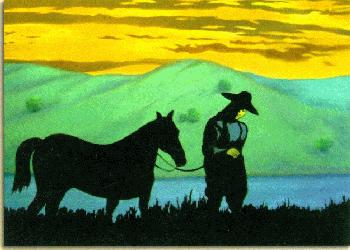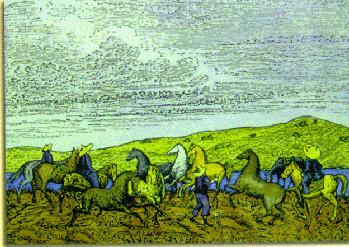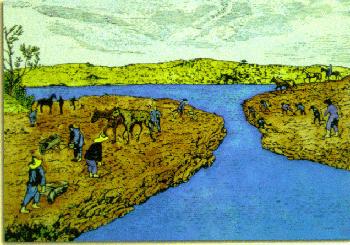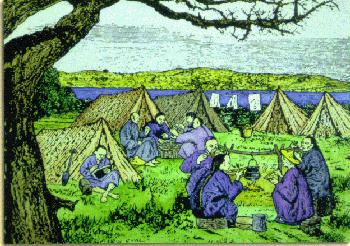 CHINESE
CHINESE
WORKERS
AND THE
EAST BAY'S
EARLY
WATER
SYSTEMS
The following document is a historical account of early California dam construction that includes references to the use of mustang horses by Chinese laborers in their construction efforts.
We thank the East Bay Municipal Utility District (Oakland, CA) for providing this historic file.
 CHINESE
CHINESE
WORKERS
AND THE
EAST BAY'S
EARLY
WATER
SYSTEMS
In the 1800's, many Chinese men immigrated to America where they hoped to find work and to save enough money to send back to their families in China. In California, Chinese laborers built the railroads and worked in the gold mines. Their tremendous contributions here are well documented. But their role in building the East Bay's early water systems had been mostly forgotten until an archaelogical excavation in 1980 near Chabot Dam revealed the remains of a Chinese worker's camp.
There has been little documentation of Chinese participation in the construction of the Oakland dams. In fact, hundreds of Chinese men, probably drifting down from work on railroads and in mines in the Sierra Nevada, provided the bulk of the heavy labor at two major dam sites. Working for less than $1 a day and risking their lives in treacherous country, Chinese worked for almost 20 years at Lake Chabot and Lake Temescal.
 Constructing
the Earthen Dam at Temescal in 1868 was a major project. Workers
first had to remove tons of wet clay and dirt. Then they had to dig deep
to find bedrock for the dam's foundation.
Constructing
the Earthen Dam at Temescal in 1868 was a major project. Workers
first had to remove tons of wet clay and dirt. Then they had to dig deep
to find bedrock for the dam's foundation.
The dam rises 105 feet above the creek, which is 322 feet above sea level. The top of the dam is 600 feet long and 16 feet wide. Today, Temescal Dam is still in good condition but no longer a part of Oakland's water system. Lake Temescal is one of Oakland's favorite swimming areas.
Even before Temescal Dam was completed, the hydraulic engineer Anthony
Chabot realized that Oakland's growing population would soon exhaust the
Temescal water supply. He selected San Leandro Creek as the site for an
even larger dam. In 1874 the Oakland City Council approved the San Leandro
Dam Project, which called for a five-billion-gallon reservoir costing $500,000.
Using hundreds of Chinese workers and mustangs, Chabot directed the construction
of the dam that was to be 100 feet high, 450 feet long, 28 feet wide at
the crest, and 900 feet wide at the base.
 Chinese
Labor was indispensable at the worksites of Chabot and Temescal
Dam. The dams were built by a process called "puddling," which
uses horses to trample the earth. Puddling made the ground as hard and
water resistant as cement.
Chinese
Labor was indispensable at the worksites of Chabot and Temescal
Dam. The dams were built by a process called "puddling," which
uses horses to trample the earth. Puddling made the ground as hard and
water resistant as cement.
At Chabot Dam, hundreds of Chinese workers using mules and mustangs made 500,000 cubic yards of concrete and packed earth. Dirt was excavated from dowstream, loaded into mule-drawn cars and packed into the body of the dam.
Chinese laborers cleared vegetation for the projects and moved masses
of earth and construction equipment. Skilled Chinese workers executed the
fine masonry finish on the dam surfaces. A major task at Chabot was blasting
three separate tunnels--totaling 3,100 feet of earth and bedrock--through
the hillsides. At least six Chinese workers lost their lives in cave-ins
and explosions during this excavation, which city officials at the time
hailed as a "monumental achievment."
 To endure the hardships of long work days in the California wilderness
and the strong anti-Chinese prejudice of their white bosses, these workers
formed communes in the camps for companionship and to preserve their cultural
heritage. As in Chinatowns all over the world, group unity helped the immigrant
Chinese workers face adversity.
To endure the hardships of long work days in the California wilderness
and the strong anti-Chinese prejudice of their white bosses, these workers
formed communes in the camps for companionship and to preserve their cultural
heritage. As in Chinatowns all over the world, group unity helped the immigrant
Chinese workers face adversity.
In their free time, the men played traditional Chinese games including
mah-jongg and pai-gow. They dressed in typical "coolie" garb,
similar to clothing worn by farmers in China, cooked Chinese food, and
wrote home whenever a courier could hand-carry a letter to family back
in China. Without women, the men did all the housekeeping chores and could
only dream of the wives or wives-to-be they had left behind.
 The
exhibition/mural Chinese Workers and the East Bay's Water Systems was
contributed by East Bay Municipal Utility District and is on view to the
public in the EBMUD Administration Center, second floor, at 375 Eleventh
Street, Oakland.
The
exhibition/mural Chinese Workers and the East Bay's Water Systems was
contributed by East Bay Municipal Utility District and is on view to the
public in the EBMUD Administration Center, second floor, at 375 Eleventh
Street, Oakland.